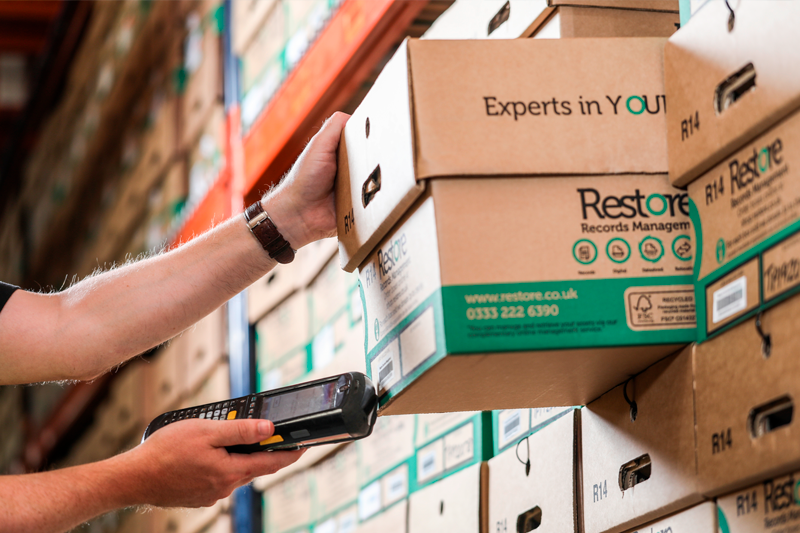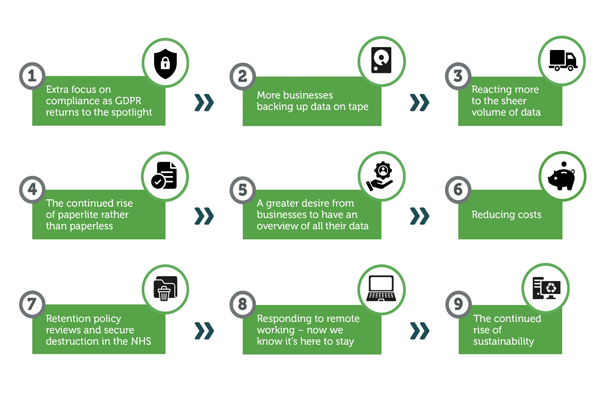
The quality of archive boxes is an under-discussed topic, but a good box means good compliance – and so it’s a conversation that needs to be aired.
It would be no surprise if some companies are tempted to look for the cheapest possible options online and see choosing a box as something of an afterthought. But our experience after 30 years in the sector is that when you are storing documents, the type of box they are housed in is vital.
If your documents are valuable to you, then what you store them in should be important too.
At Restore Information Management, we actively manage the quality of archive boxes coming into our premises and we source and sell our own boxes, too. In fact, boxes are everything to us.
Here are a few top tips when choosing an archive box:
Think about data protection and compliance
Protecting the integrity of your data should be paramount when choosing archive boxes, so think about quality first and foremost.
A cheaper box may seem like good value, but the reality is it will rip and disintegrate quickly – and the consequences are significant. If the box falls apart when being handled there may be a risk of documents being lost or damaged. That’s a major consideration in a world in which data protection is big news.
Any documents with a retention year of eight years or more require a box that can last, so it makes sense to invest in quality from the start.
Consider quality rather than price
The type of cardboard used for archive boxes is important. It needs to be of a certain gauge to make it a solid structure in order to protect your documents.
It should also include a strong lid that forms part of the handles. A good lid doesn’t fall off when the box is being moved and a strong handle is critical for obvious reasons. There should also be space on the box to capture information about what’s inside.
For instance, the design of boxes offered by Restore Information Management ensures the correct information is entered in the right place on the box, meaning it can be quickly recorded.
There is a specific place for a bar code – only on one side of the box. This stops people from attaching multiple bar codes. There are also data fields which customers can fill in – and which we can capture.
So, next time you are looking at boxes on the internet, take time to think. There are many benefits to investing in a higher-quality box directly from us.
After all, if you spent £1000 on an iPhone you wouldn’t spend 20p on a protective case for it. If you value your documents, the quality of the box they are stored in is crucial.
Run through our useful checklist
Are your archive boxes strong enough – are they overfilled?
Low-quality boxes seem fine in the short term, but they disintegrate and deteriorate more quickly. And if you have boxes which contain documents which are regularly needed, it’s inevitable there is an impact on the box eventually. Every time you pull it from the shelf, pressure is exerted on the box and it can rip.
Overfilling archive boxes is a regular problem and one that we see all the time! Not only does it make it more likely the box will break, but there is also a human impact. They are too heavy to lift.
Never fill a box right to the top – because then documents are more likely to fall out.
At Restore Information Management, our archive boxes are specifically designed to remain below 15kg and include a line to show how far they should be filled.
Is the box suitable?
We’ve seen people using a photocopier paper box for storage thinking it’s a strong box that was filled with paper before. But it hasn’t got any handles on it so can be difficult to move.
They also buy cheap boxes from supermarkets or online sites that never last long and not only deteriorate quickly but can be a threat to the integrity of the documents stored.
Another mistake is using glue and Sellotape to try and strengthen the corners of boxes. But once Sellotape has been in store for a few years it dries out and just falls off.
Does your box require extra protection?
For extra peace of mind, choose a box that has the capacity to add anti-tampering measures – such as security tags to prevent unauthorised people from opening the lid and viewing documents inside.
Are you future-ready?
Most organisations are looking to reduce inventories, so even if you are storing boxes on your own premises for now, it’s good to think about the future. There may well come a time when it’s right to outsource.
A good tip is to invest in high-quality boxes from the start.
When we do an uplift of boxes for a new client, we always tell them if the boxes are using are not fit for purpose – and they may need to be re-boxed.
Choose Restore Information Management for your boxes
Our boxes are designed especially for us by our suppliers to ensure they are fit for purpose – and we carefully monitor them.
And if you need a specific style of box, we can arrange that. We provided 800,000 bespoke boxes to a client recently because the files they wanted to store were larger than usual, for instance.
Every box stored on our premises is bar-coded to enable data capture and file tracking, and the boxes are designed to make the capture of information quick and efficient. So, put the shoe boxes, photocopier boxes and online ‘bargains’ to one side.
If you value your documents, value your boxes, too.



